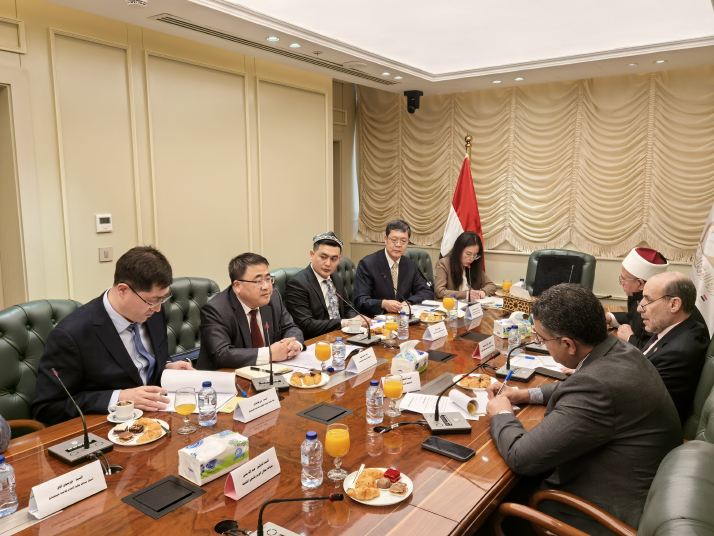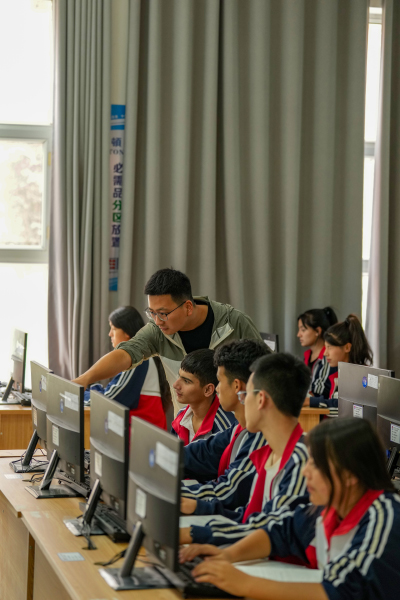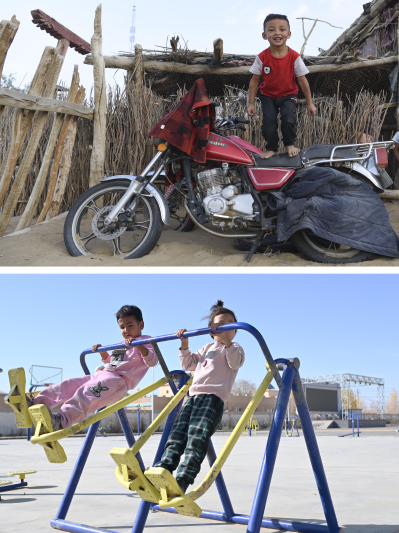| Xinjiang Today |
| Shared aspirations for modernization | |
|
|
 Tuersun Aibai (left) and other members of a Chinese delegation hold a discussion with officials of the Egyptian Ministry of Religious Endowments in Cairo on February 19 (COURTESY PHOTO)
From February 18 to 27, my colleagues and I visited Egypt, Oman and the United Arab Emirates (UAE), and engaged in extensive discussions with representatives from international organizations, government departments, media outlets, research institutions and more.
We shared Xinjiang's human rights protection and socioeconomic achievements while learning about the local culture and society. This was my second visit to the Middle East, and it was insightful and rewarding.  Li Bin, a teacher from Zhejiang Province, teaches e-commerce at a vocational school in Alaer City in September 2024. Experienced teachers from Taizhou, a city in the eastern province of Zhejiang, work in Alaer for 1.5 years at a time as part of a Xinjiang assistance program (XINHUA)
A tailored approach
Due to differences in historical traditions and levels of economic development, modernization varies across nations in the Middle East. There is no single model for achieving modernization. Each country must pursue a path suited to its national conditions to ensure social stability and economic development. Egypt promotes economic growth by developing market systems, industrial infrastructure, education and legal frameworks. Oman adjusts its industrial structure by investing in tourism, fisheries, port trade and international logistics, in order to balance modernization with traditional culture. The UAE customizes economic strategies for different regions, achieving development through export and re-export. Choosing the right modernization path is crucial for national progress and improving citizens' wellbeing. Openness and inclusiveness have become core governance principles and a societal consensus in many countries. The three countries, home to diverse religions and cultures, exemplify this approach. Grand mosques and churches, and people of various ethnicities coexist harmoniously. During the exchanges, officials and scholars emphasized that inclusive policies play a vital role in promoting ethnic and religious harmony. These nations enact laws to protect the rights of diverse ethnic and religious groups, and incorporate openness and inclusivity into educational and social programs to reinforce these values. Given the multicultural and multi-religious nature of Arab nations, maintaining national unity and religious harmony is a top priority for their governments. To foster a strong national identity, these countries establish specialized government agencies and strategic plans to ensure equal public services for all citizens, implement systematic civic education to strengthen national cohesion and prevent sectarian conflicts, and enforce laws to ensure equal rights and obligations for all. The governments have taken structured approaches to religious affairs, including establishing institutions for religious management, publishing religious texts and materials to promote responsible practices, providing regular training for religious leaders, and encouraging dialogues to regulate religious activities and foster harmony among different religious groups.  Daliyabuyi Village in Yutian County, Hetian Prefecture in September 2018 (above) and November 2024. The village, once located at the heart of the Taklimakan Desert, the second largest shifting desert in the world, was relocated to a more livable area as part of China's poverty alleviation campaign (XINHUA)
Shared objectives China and Arab countries share similar governance philosophies and development goals. For example, in January 2019, Egypt launched the Decent Life Initiative, aiming to boost economic growth, create jobs and improve living standards. This initiative aligns with China's creation of a moderately prosperous society and the country's poverty alleviation efforts, both of which focus on economic development and improving people's wellbeing. As part of the process of Chinese modernization, Xinjiang has steadily advanced in alignment with the trend. In 2020, Xinjiang eradicated absolute poverty, lifting 3.06 million rural residents in 3,666 impoverished villages and 35 counties out of extreme poverty. In 2023, Xinjiang ranked among the top five regions in China for growth in GDP, investment, consumption, international trade, fiscal revenue and residents' income. In 2024, over 1.74 million residents in Xinjiang (out of a total of 25.98 million) held a bachelor's degree or higher. The region's GDP reached 2.05 trillion yuan ($280 billion), from 1.35 trillion yuan ($190 billion) five years earlier. It had 579,700 enterprises, with 92,000 newly established businesses that year. The urbanization rate rose to 59.24 percent from 51.87 percent five years earlier. The per-capita disposable income reached 30,899 yuan ($4,256)—compared to 23,103 yuan ($3,182) in 2019. Some 483,200 urban residents secured new jobs. Xinjiang respects and protects diverse cultural traditions to ensure harmonious coexistence among the various ethnic groups residing in the region. It actively preserves and promotes ethnic cultural heritage. Currently, Xinjiang is home to many ethnic groups and multiple religions including Islam, Buddhism, Taoism and Christianity. The Xinjiang Regional People's Congress and its Standing Committee have enacted two regional laws to promote ethnic unity. To strengthen national identity and civic awareness, Xinjiang prioritizes ethnic unity by enhancing legal frameworks, strengthening cultural ties, improving living standards, and encouraging inter-ethnic interactions. Through these efforts, it fosters a stronger sense of the Chinese nation as one community. The region protects freedom of religious belief while also preventing the spread of religious extremism—a governance approach similar to that of Arab countries. Currently, Xinjiang has more than 20,000 mosques. It has 103 Islamic associations and 10 Islamic colleges that provide religious training, as well as academic and cultural exchanges to support religious communities. Islamic texts, including the Quran, are translated and published in multiple languages. The Xinjiang Uygur Autonomous Regional Islamic Association publishes the Xinjiang Muslims magazine in the Uygur, standard Chinese and Kazak languages. No fewer than 1,436 religious figures in Xinjiang serve as deputies to people's congresses, which are local and national legislatures, and members of the Chinese People's Political Consultative Conference committees, political advisory bodies, having a say in state affairs. China and Arab countries are ancient civilizations with millennia-old friendships. Historically, Sino-Arab exchanges have contributed to remarkable achievements in human civilization. Through initiatives like the Belt and Road Initiative (BRI), boosting connectivity along and beyond the ancient Silk Road routes, China is working toward a shared future for humanity. Similarly, Arab countries are exploring development paths suited to their national conditions, and modernizing their economies while contributing wisdom and strength to global progress. As the core hub of the BRI and a gateway for westward opening up, Xinjiang plays a pivotal role in connecting China and Arab countries. During this visit, I felt the firm support of Arab nations for the Chinese Government's policies on Xinjiang and their appreciation for the region's economic and social achievements. Looking ahead, with the continued advancement of the BRI, Xinjiang is set to become a crucial bridge for strengthening Sino-Arab ties and a key platform for fostering mutual trust and cooperation. XT The author is an associate professor at the School of Journalism and Communication at Xinjiang University Comments to ffli@cicgamericas.com Egyptian, Chinese Experts Highlight Xinjiang Development Egyptian and Chinese experts convened in Cairo, Egypt, on February 18 to discuss the economic and social development in China's Xinjiang Uygur Autonomous Region. Xing Guangcheng, Director of the Institute of Chinese Borderland Studies under the Chinese Academy of Social Sciences, elaborated on China's policies and practices to bolster the region's economic and social development. As a scholar who has long worked and lived in Xinjiang, Tuersun Aibai, an associate professor at Xinjiang University's School of Journalism and Communication, highlighted the achievements in Xinjiang's development and human rights endeavors, including the right to work. He said the development of Xinjiang allows people from all ethnic groups in the region to enjoy better quality of life. He also expressed the region's desire to engage in broad exchanges with individuals from outside China, build mutual understanding and collaborate to further the progress of human rights worldwide. Ali El-Hefny, Vice Chairman of the Cairo-based Egypt-China Friendship Association and former Egyptian Ambassador to China, commended China's comprehensive approach to improving living standards for all ethnic groups in Xinjiang. "The great development witnessed by Xinjiang can serve as a guide for developing countries, especially Egypt, given the similarities in geography and economic structure between the two regions," El-Hefny said. Abu Bakr al-Deeb, advisor to the Cairo-based Arab Center for Research and Studies, said he saw a prosperous region when he visited Xinjiang last year, with booming sectors including agriculture, industry and culture. The development experience of Xinjiang is worthy of study, the expert said. The event, organized by China's State Council Information Office in cooperation with the Chinese Embassy in Egypt, offered a platform for the Arab country to gain insights into Xinjiang's substantial progress in human rights and development. (Source: Xinhua News Agency) |
|
||||||||||||||||||||||||||||
|